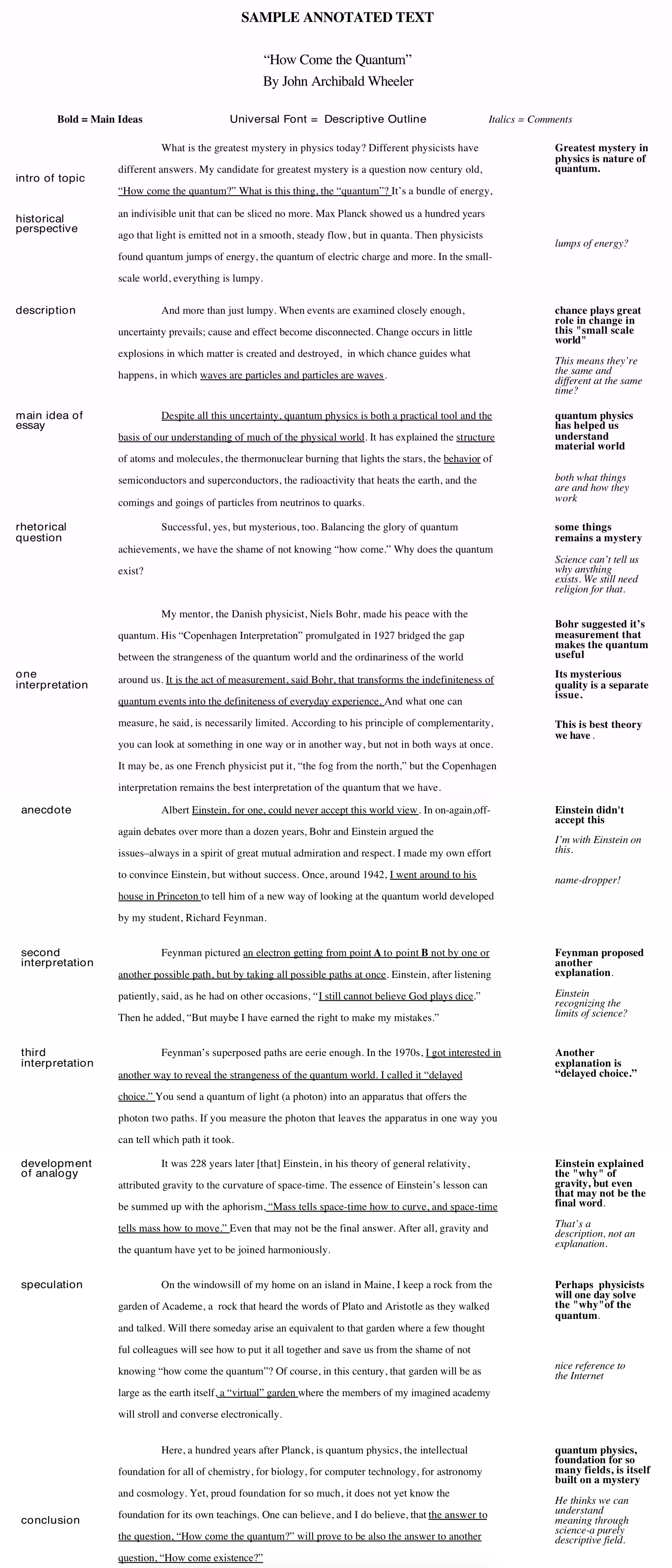2.1.1.6: Hunter College Reading/Writing Center
- Page ID
- 14992
THE WRITING PROCESS
Invention: Annotating a Text
Annotating a text, or marking the pages with notes, is an excellent, if not essential, way to make the most out of the reading you do for college courses. Annotations make it easy to find important information quickly when you look back and review a text. They help you familiarize yourself with both the content and organization of what you read. They provide a way to begin engaging ideas and issues directly through comments, questions, associations, or other reactions that occur to you as you read. In all these ways, annotating a text makes the reading process an active one, not just background for writing assignments, but an integral first step in the writing process.
A well-annotated text will accomplish all of the following:
- clearly identify where in the text important ideas and information are located
- express the main ideas of a text
- trace the development of ideas/arguments throughout a text
- introduce a few of the reader’s thoughts and reactions
Ideally, you should read a text through once before making major annotations. You may just want to circle unfamiliar vocabulary or concepts. This way, you will have a clearer idea about where major ideas and important information are in the text, and your annotating will be more efficient.
A brief description and discussion of four ways of annotating a text and a sample annotated text follow:
!Highlighting/Underlining
Highlighting or underlining keywords and phrases or major ideas is the most common form of annotating texts. Many people use this method to make it easier to review material, especially for exams. Highlighting is also a good way of picking out specific language within a text that you may want to cite or quote in a piece of writing. However, over-reliance on highlighting is unwise for two reasons. First, there is a tendency to highlight more information than necessary, especially when done on a first reading. Second, highlighting is the least active form of annotating. Instead of being a way to begin thinking and interacting with ideas in texts, highlighting can become a postponement of that process.
On the other hand, highlighting is a useful way of marking parts of a text that you want to make notes about. And it’s a good idea to highlight the words or phrases of a text that are referred to by your other annotations.
!Paraphrase/Summary of Main Ideas
Going beyond locating important ideas to being able to capture their meaning through paraphrase is a way of solidifying your understanding of these ideas. It’s also excellent preparation for any writing you may have to do based on your reading. A series of brief notes in the margins beside important ideas gives you a handy summary right on the pages of the text itself, and if you can take the substance of a sentence or paragraph and condense it into a few words, you should have little trouble clearly demonstrating your understanding of the ideas in question in your own writing.
!Descriptive Outline
A descriptive outline shows the organization of a piece of writing, breaking it down to show where ideas are introduced, where they are developed, and where any turns in the development occur. A descriptive outline allows you to see not only where the main ideas are but also where the details, facts, explanations, and other kinds of support for those ideas are located.
A descriptive outline will focus on the function of individual paragraphs or sections within a text. These functions might include any of the following:
- Summarizing a topic/argument/etc.
- Introducing an idea
- Adding explanation
- Giving examples
- Providing factual evidence
- Expanding or limiting the idea
- Considering an opposing view
- Dismissing a contrary view
-
Creating a transition
-
Stating a conclusion
This list is hardly exhaustive and it’s important to recognize that several of these functions may be repeated within a text, particularly ones that contain more than one major idea.
Making a descriptive outline allows you to follow the construction of the writer’s argument and/or the process of his/her thinking. It helps identify which parts of the text work together and how they do so.
!Comments/Responses
You can use annotation to go beyond understanding a text’s meaning and organization by noting your reactions–agreement/disagreement, questions, related personal experience, connection to ideas from other texts, class discussions, etc. This is an excellent way to begin formulating your own ideas for writing assignments based on the text or on any of the ideas it contains.


